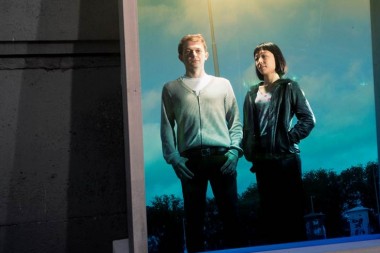Centraal Museum Utrecht acquired the artist’s proof #1 edition of Red blue Lego chair from our collection. It will be exhibited at Rietveld’s Universe as part of Rietveld Year organized by the Centraal Museum in Utrecht to celebrate the life and heritage of Gerrit Rietveld from October 20th, 2010 until January 30th, 2011. Here is our Q&A with Rotterdam-based designer, Mario Minale of Minale-Maeda (pictured with Kuniko Maeda).

What was your starting point for this chair?
There is this expression in the world of theatre, “breaking the fourth wall.” It’s about bringing in something unexpected. It’s about addressing the audience, taking them out of their lull and involving them, even passing the responsibility onto them.
What I don’t like about icons is that we just accept them, and we no longer know what they mean, and then they are copied time and time again. I was looking for something unexpected in making a copy of an icon. I wanted to break the mould and no longer see an icon as something set in stone.

What was “the fourth wall” in your design?
It was the appropriation of two icons in a way that creates something new. I started with Rietveld’s iconic Red blue chair and brought in equally iconic Lego blocks, and I think because the spirit of Rietveld and of Lego aligned, it created a breed that resonates.
Why did you work with Rietveld’s chair?
Rietveld intended his chair to be a blueprint from which anyone could make his own chair out of readily available material. For Rietveld, variations of his design were intended. That is why the construction of his chair is so simple. There are no dovetails or other complicated joinery.
Why did you bring in Lego?
Lego represents the construction material of our age—it is convenient. It makes personal expression easy. It is a material that empowers the unqualified to create by themselves.
For Rietveld, it was boards cut to size at the sawmill that made his design accessible. One no longer had to go to the woods to chop a tree thanks to industry. For us, it is no longer about cutting and sawing, but rather about blocks that snap together, shiny finish included. Rietveld broke the chair into 14 pieces to make it easy. Lego breaks it into 4445 pieces, which makes it even more easy.
Was it in fact easy to make this chair?
Not at all. Lego is a basic toy, but the process of making a chair out of it became so complicated that it questioned the simplicity that Lego promised. The process I went through makes the chair an even more authentic copy. The result of making a copy is not a copy. It’s an authentic act.
Lego has the same tension. It stands for simplicity, but the moulds to make Lego are a best kept secret, and that’s why there are no knock-offs. One cannot get rid of complexity but can only displace it. This chair is a metaphor for that.
What do you think of the copyright laws that prevented a larger production of the Lego chair?
One cannot get the Rietveld chairs anymore. Finding a way to copy it makes it accessible, and this was my intention. The fact that copyright laws prevented us from making a larger production of the Red blue Lego chair intensifies this discussion.










